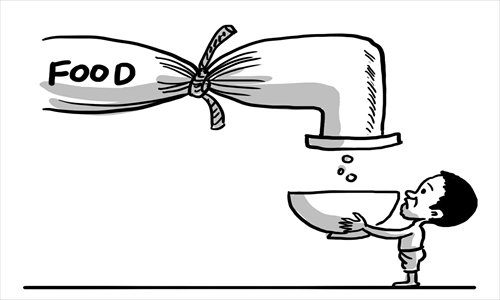India campaign on malnutrition faces monumental challenges to succeed

Illustration: Liu Rui/GT
Hunger is the subject of many discussions in India. The Indian subcontinent is home to a quarter of the world's hungry, according to the UN's World Food Programme. As many as 250 million people who live in extreme poverty aren't sure when or how they'll get their next meal.
Indian Planning Commission data released last week tells a different story, namely that the number of people living in extreme poverty has decreased from 37 percent to 22 percent in the past seven years.
The news comes at a time when malnutrition remains an everyday reality in the country despite food mediation schemes.
The National Food Security Bill was first introduced in parliament in 2011 to combat hunger by guaranteeing food at subsidized prices to more than two-thirds of the population and tackling chronic malnutrition and hunger.
Earlier this month, on July 3, the government announced a food security order which aims to provide 5 kilos of grain per person per month at subsidized rates to approximately 800 million people, making it one of the largest food welfare programs ever.
The government would also provide cash to beneficiaries in case the state failed to timely provide food.
Critics say this would be a huge burden on the country's growing current account deficit as the subsidized food would cost the nation an estimated $22 billion annually.
However, it remains a challenge for India to successfully formulate and implement this ambitious project with rising inflation in the country.
Getting one nutritionally balanced meal a day for people living below the poverty line in the subcontinent is a challenge, and this order would fulfill this basic want.
The Indian government's National Family Health Survey highlights a fundamental crisis in that nearly half of children below 5 years old suffer from malnutrition and a third of women are underweight.
The primary reason for undernourished children is the poor nutrition of women during pregnancy. We should start thinking about long-term solutions to chronic malnutrition and hunger.
First, we have to make sure that the measures contained in this scheme reach the intended beneficiaries. Otherwise we will continue indefinitely in a vicious cycle where our children are plagued by nutritional deficiencies.
In the second place, every year tons of food rots inside government warehouses owing to shoddy storage facilities.
In the words of Amartya Sen and Jean Dreze, this is a "scandalous phenomenon," a "situation of hunger amidst plenty." India grows enough food to feed its own population according to the World Food Programme. We need to constantly check the distribution system for leaks.
Third, given recent incidents regarding food safety as well as nutrition security, I hope that food security and nutritional security will be integrated in the broader theme of food safety.
Simply providing subsidized food is unlikely to resolve the nutrition problem.
It is important that the government identify beneficiaries properly and reconstruct a new model for the public distribution system. The current system is meant to help 400 million people, but it remains hideously ineffective and corrupt and has been unable to tackle the food needs which it was meant to.
Last, local government interventions must be made to provide access to safe drinking water to end malnutrition. This will also address the interests of our farmers for agricultural sustainability and productivity over time.
Agricultural reforms are a must to secure the interests of small and marginal farmers, which will go a long way toward solving food shortages.
If the order is passed and made into law, then this welfare project has to create additional allocations for storage warehouses and transport facilities.
We need to give our best shot to tackling hunger and eliminating under-nutrition, or India will never rise to its full potential.
The author is a Master's candidate in Global Business Journalism at Tsinghua University. himanshu28102000@gmail.com